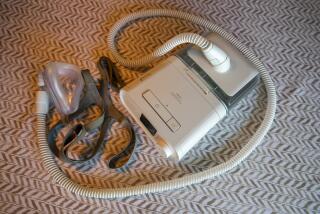The FDA warns against leaving vena cava filters in for too long
- Share via
The Food and Drug Administration on Monday warned physicians and patients against leaving vena cava filters -- designed to filter blood clots from the veins and prevent them from reaching the heart -- in patients for extended periods of time because the devices have a disturbing tendency to create problems, some of them life-threatening.
The filters are tiny, spider-like implants that are placed into the inferior vena cava, which returns blood from the lower half of the body to the heart. They have thin metal legs that hold them in position in the vein and others that filter out blood clots before they can reach the heart. The devices are primarily used to treat venous thromboembolism, or the formation of blood clots in the veins. About 200,000 Americans develop this problem each year. The first-line therapy is treatment with anti-clotting and blood-thinning drugs. When those medications don’t work or the patient is unable to use them, the filters can be surgically implanted.
In 1979, only 2,000 of the filters were implanted, but by 2007, the number had grown to 167,000 per year according to the FDA. The agency predicts that about 259,000 will be implanted in 2012. Many of the devices are designed for short-term use until the underlying cause of the thromboembolisms is removed, but others are approved for permanent implantation.
The FDA said that, since 2005, it has received 921 reports of problems caused by the filters. That included 328 instances in which the devices migrated from their original emplacements, 146 cases in which parts broke off and migrated through the blood vessels, 70 cases in which the blood vessel was punctured and 56 instances in which the filter fractured. The agency said that physicians should give strong consideration to removing the devices once their role has been completed.
The warning came in conjunction with a report Monday in the Archives of Internal Medicine detailing one hospital’s experiences with one brand of the devices. Dr. William Nicholson of York Hospital in York, Pa., and his colleagues decided to look back at all the patients who had received filters manufactured by Bard Peripheral Devices of Tempe, Ariz., at their hospital after one of their patients required emergency open-heart surgery to remove part of a leg that had migrated to his heart, causing a variety of problems.
Six physicians in three disciplines had implanted a total of 189 of the Bard devices at York Hospital from April 2004 to January 2009. The team was able to study 80 of the patients, subjecting them to fluoroscopy to determine if the devices had broken and additional tests if the first revealed a problem. Overall, they found that 16% of the devices had lost all or part of at least one leg. That included seven of 28 first-generation devices (25%); in at least five of the seven cases, the fragment had traveled to the heart. In second-generation devices that had supposedly been improved to reduce the risk of fracture, six of 52 (12%) had fractured, the team found. However, they cautioned that those devices had been in use for only half as long and that the fracture rate over the first years of their use was comparable to that of the first-generation devices during the same period.
Nicholson and his colleagues said that the second-generation Bard filter had been implanted in more than 65,000 patients nationwide since September 2005. Bard did not respond to requests for comment.
-- Thomas H. Maugh II





